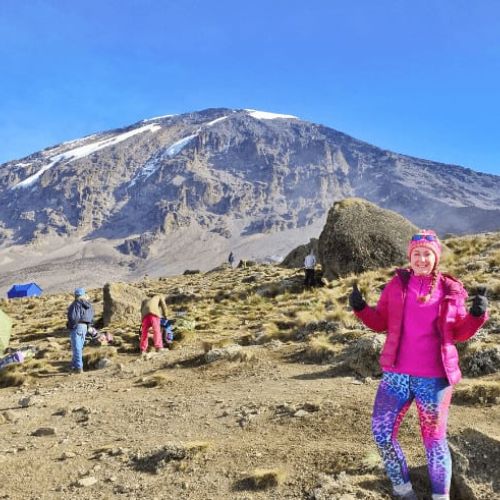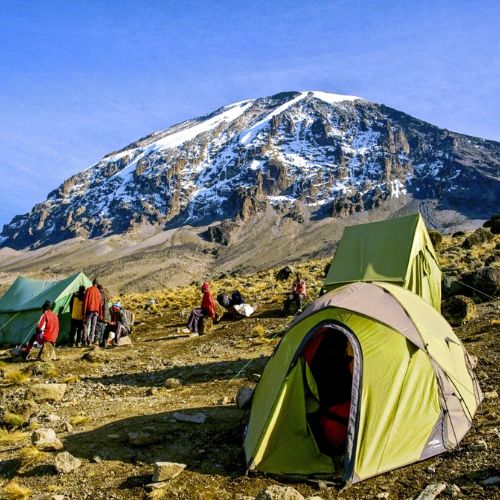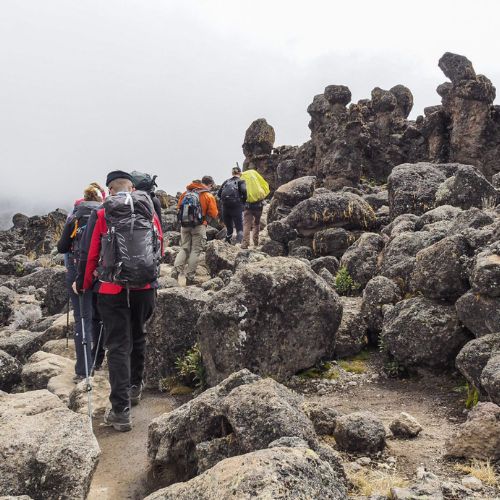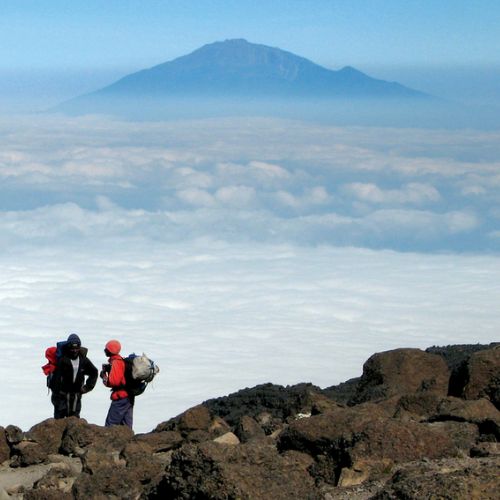6 Days Marangu Route
TICKETS
HOTELS
GUIDE
FOOD
PARK ENTRY
VEHICLE
Tour Overview
The Marangu Route, affectionately known as the “Coca-Cola” route, is the oldest and most established path to Mount Kilimanjaro’s summit. Renowned for its relatively gentle gradient and well-maintained trails, it is the only route offering hut accommodations, providing trekkers with added comfort at Mandara, Horombo, and Kibo Huts.
Our 6-day climb begins at the lush rainforest of Marangu Gate, ascending through diverse ecological zones. Starting with the vibrant rainforest, the trail transitions into moorlands where you’ll encounter striking giant lobelias and groundsels. Continuing upward, you will traverse the surreal alpine desert before finally reaching the snowy summit of Uhuru Peak.
Key highlights of this route include the serene Mandara Hut nestled in the rainforest, the stunning panoramic views from Horombo Hut, and the vast moonscape of the Saddle between Kibo and Mawenzi. The awe-inspiring sunrise at Gillman’s Point is a prelude to the triumphant moment of reaching Africa’s highest point, Uhuru Peak.
The extra acclimatization day at Horombo Huts enhances your chances of a successful summit. The descent retraces the upward journey, allowing you to experience the varied landscapes from a new perspective. The adventure concludes with a celebratory return to Moshi, where you’ll reflect on an unforgettable journey to the roof of Africa.
Day-by-Day Itinerary
Day 1: Marangu Gate to Mandara Huts: 8.3km / 5mi | 4-5 hours | Rainforest
Elevation: 1905m/6250ft to 2723m/8934ft
Altitude gained: 818m
Your journey begins with a one-hour drive from Moshi to the Kilimanjaro National Park Gate, passing through the charming village of Marangu. At the park gate, we’ll wait for our permits while observing the vibrant activity of crews preparing for their treks. As we embark on the trail, enjoy the lush rainforest scenery and winding paths. Our knowledgeable guide will share insights about the local flora, fauna, and wildlife. The trail at these lower elevations can be muddy and slippery, so we recommend using gaiters and trekking poles.
Day 2: Mandara Huts to Horombo Huts: 11km / 6-8 hours | Moorland
Elevation: 2740m/9000ft to 3690m/12,100ft
Altitude gained: 950m/3100ft
After a restful night and a hearty breakfast, we leave the rainforest and follow an ascending path through heathland, spotting giant lobelias and groundsels along the way. As we progress into the open moorlands, you’ll notice the landscape dominated by small shrubs. We’ll pause for lunch and take in the stunning views of Mawenzi. By late afternoon, we’ll reach the Horombo Huts, situated beneath the impressive Kibo Summit. Expect cooler temperatures as night falls.
Day 3: Acclimatization Day at Horombo Huts
Spend a full day and a second night at Horombo Huts. On this day, you can either rest at the huts or take a stroll up to the Mawenzi base camp and then return to the Horombo Huts. This extra day will help your acclimatization and further your understanding of the mountain’s weather and altitude. After your pause, you will continue up to the Kibo Huts on your fourth day for your midnight start to the summit.
Day 4: Horombo Huts to Kibo Huts: 10km / 6-8 hours | Semi-Desert
Elevation: 3690m/12,100ft to 4695m/15,400ft
Altitude gained:1005m/3300ft
Following breakfast, we trek through the diminishing heathland, transitioning into a moonscape as we approach the vast saddle connecting Mawenzi and Kibo. We’ll stop for lunch and take time to observe the path we’ll be taking for the summit climb up Kibo. This stretch provides an excellent opportunity to acclimatize and prepare for the challenging ascent ahead.
Day 5: Kibo Huts to Summit back to Horombo Huts: 4km / 5-7 hours up, 14km / 5-6 hours down | Glaciers, Snow-Capped Summit
Elevation: 4695m/15,400ft to 5895m/19,340ft (Summit), then down to 3690m/12,100ft
Altitude gained: 1200m/3940ft (up), Altitude lost: 2205m/7240ft (down)
We start our summit attempt early, between midnight and 2 a.m. This is the most demanding part of the trek, both mentally and physically. Moving in a switchback pattern, we’ll climb through heavy scree and possibly snow towards Gillman’s Point on the crater rim. Here, you’ll be rewarded with a breathtaking sunrise. The final hour’s ascent to Uhuru Peak will likely be through snow. Congratulations, you’ve reached Uhuru Peak, the highest point on Mount Kilimanjaro and the African continent!
After celebrating this incredible achievement, we begin the steep descent to Mweka Camp, stopping briefly at Barafu for lunch. The loose gravel and volcanic ash terrain make gaiters and trekking poles essential. Enjoy a well-deserved rest on your final night on the mountain.
Day 6: Horombo Huts to Marangu Gate then back to Arusha/Moshi: 18km / 6-7 hours | Rainforest
Elevation: 3690m/12,100ft to 1830m/6000ft
Altitude gained: 1860m/6100ft
After breakfast, we have a heartfelt farewell ceremony with our crew. As we continue our descent, we’ll stop at Mandara Huts for lunch. It’s customary to tip your guides, cooks, and porters here. Upon reaching the Marangu Park Gate, you’ll receive your summit certificates. The warmer, wet, and muddy terrain on the descent calls for gaiters and trekking poles. A vehicle will then drive you back to your hotel in Arusha/Moshi, where a hot shower, dinner, and celebrations await.
Tour Price Inclusion and Exclusion
- Park fees
- All activities (unless labeled as optional)
- All accommodation as stated in the itinerary
- A professional driver/guide
- All transportation (unless labeled as optional)
- All Taxes/VAT
- Roundtrip airport transfer
- All Meals (as specified in the day-by-day section)
- International flights (from/to home)
- Additional accommodation before and at the end of the tour
- Tips (tipping guideline US$10.00 pp per day)
- Personal items (souvenirs, travel insurance, visa fees, etc.)
- Government imposed increase of taxes and/or park fees
- Alcohol drinks






